Was ‘The Wickedest Man in the World’ Buried Just Outside of Bucks County? Here’s What We Know

According to several sources, one of the most infamous personalities of the last century may have found his resting place just outside of Bucks County.
Aleister Crowley, dubbed by many publications as “The Wickedest Man in the World”, was an English author and occultist, who founded the spiritual philosophy/religion of Thelema back in the early 1900s. To some, he was an evil character who practiced black magic and other troublesome occult activities. To others, he was a prophet of a new way of life, leading mankind into a new realm of spirituality and self-development.
Given his reputation, it would be easy to assume that his remains can be found in a regal tomb in his native England, decorated with occult imagery and maybe even some Ancient Egyptian calligraphy, as he was very influenced by the myths and religion of the long-gone civilization. But, like so many other things in life, that would be too good to be true.
According to several sources, including the books “A Magick Life: A Biography of Aleister Crowley” by Martin Booth and “Aleister Crowley: Magick, Rock and Roll, and the Wickedest Man in the World” by Gary Lachman, Crowley’s remains, having been cremated after his death in late 1947, were given to his associate Karl Germer, who took them back to his estate in Hampton, New Jersey, about a half-hour outside of Bucks County.
It was here where, according to biographers and those who knew Germer, the occultist’s ashes were either buried in or scattered atop Germer’s garden. Another source says that Germer’s wife, Sascha, scattered the ashes around a tree on the property.
The private property, where the ashes were allegedly scattered, sits near the Musconetcong River.
Regardless of the the public’s opinion of him, he was an influential figure in his day and after. Many attribute his teachings to the rise of new age beliefs and religions, as well as the counterculture revolution of the 1960s.
To many, his phrase “Do What Thou Wilt” became a philosophical statement for individual freedom, and the top musicians of the counterculture found him to be a fascinating figure; his ominous face can be seen in the top-lefthand corner of the cover of the Beatle’s “Sgt. Pepper’s Lonely Hearts Club Band” and his signature phrase was engraved into early pressings of Led Zeppelin’s third album, as guitarist Jimmy Page had an avid interest in the occultist’s works.
_____
Editor’s Note: This post first appeared on BUCKSCO Today in May 2023.
Connect With Your Community
Subscribe for stories that matter!
"*" indicates required fields





























